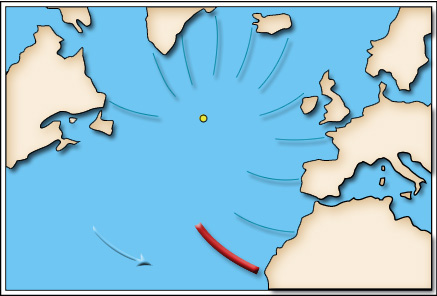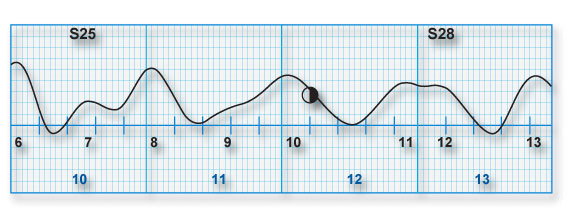As the Earth completes one revolution on its axis, in most basins, two tide waves are generated for each tidal basin; in a small number of basins, only one tide wave is generated for each basin.
==========================================================
index tides ||| © copyright notice
============================================================
Generally, the tide waves reach a coast twice per day. In that case, we usually say that the tide cadence is semi-diurnal.
In some seas, the tide wave reaches the coast once per day. Then the tide cadence is usually considered diurnal.
In other words, during the time the Earth revolves on its axis one time, in almost all the basins, there are two tide waves, while in just a few basins, there is only one.
Example of a complete turn of a tide wave.
Figure # 1

A tide cycle may have either a daily cadence (long duration), or most commonly a semi-diurnal cadence (short duration).
In a tide basin, where the tide cadence is semi-diurnal, the tide wave takes, on average, 12 hours and 25 minutes to go round completely.
While, in a tide basin, where the cadence is diurnal, on average, it takes 24 hours and 50 minutes.
In the inductive approach ...
Distinction between tide generation and tide wave.
First, because a distinction is made between two phases of an event [from the list]:
(#18) the tide generation (water density decrease),
and (#23) average delay of a tide wave to reach the coast.
At a given location, the tide generation is clear-cut; it has either a diurnal, or semi-diurnal cadence. It is the generation phase that counts.
The tide waves - their number per day, their largeness, and the intervals - are consequences of also other variables.
Fusion of two tide waves.
At times, even in a semi-diurnal basin, there is only one tide wave during one day. That occurs when a wave which is early (by convention, even number wave), comes near the preceding wave, which happens to be late (odd number wave).
see convention
In fact, to the tidal waves of a group of two, an odd number is attributed to the one which comes first, but is late. While an even number is attributed to the wave which comes second, but is early.

Here the Moon reaches a declination of 28 degrees south on the 13th day of March 2007.
Then, two tide waves become one, and a semi-diurnal basin seems to have become a diurnal one. As a matter of fact, the cadence is still semi-diurnal.
more at:
reduced interval between two tide waves.
[a semi-diurnal basin becomes apparently a diurnal basin]
Local magnetism and daily cadence.
The reason that the cadence of the tide waves can be either semi-diurnal (most of the times) or diurnal could be found in magnetism. In this site, it is postulated that the local magnetic features are essential in the cumulative-dissipative processes.